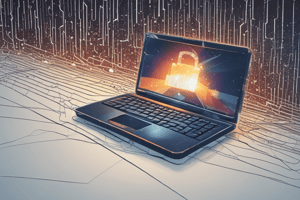Podcast
Questions and Answers
What is the term for damage or unauthorized modification of an information asset?
What is the term for damage or unauthorized modification of an information asset?
- Data Leakage
- Loss (correct)
- Integrity Breach
- Security Flaw
What is the main focus of the Maintenance & Change phase in the SDLC?
What is the main focus of the Maintenance & Change phase in the SDLC?
- Developing new systems
- Implementing security protocols
- Conducting user training
- Supporting and modifying the system throughout its lifecycle (correct)
Which component of Information Systems has significantly increased the demand for computer security measures?
Which component of Information Systems has significantly increased the demand for computer security measures?
- Data Storage
- Software Development
- Hardware
- Networking (correct)
What is often considered the most crucial yet overlooked element influencing information systems success?
What is often considered the most crucial yet overlooked element influencing information systems success?
What does the Physical Design phase in SDLC involve?
What does the Physical Design phase in SDLC involve?
Which type of user authentication credential depends on items the user possesses?
Which type of user authentication credential depends on items the user possesses?
What term describes written instructions that must be secured from unauthorized access?
What term describes written instructions that must be secured from unauthorized access?
What does the term 'Risk' refer to in the context of organizations?
What does the term 'Risk' refer to in the context of organizations?
What is the term for a documented process to take advantage of a vulnerability in software?
What is the term for a documented process to take advantage of a vulnerability in software?
Which of the following describes a condition where a vulnerability is known to an attacker?
Which of the following describes a condition where a vulnerability is known to an attacker?
What does the Implementation phase in SDLC primarily focus on?
What does the Implementation phase in SDLC primarily focus on?
What is the main goal of Information Security?
What is the main goal of Information Security?
What does Integrity in information systems mean?
What does Integrity in information systems mean?
In the SDLC, the Investigation approach focuses on which aspect of project management?
In the SDLC, the Investigation approach focuses on which aspect of project management?
What is the role of Hardware in an information system?
What is the role of Hardware in an information system?
In which phase of the SDLC are applications capable of providing needed services selected?
In which phase of the SDLC are applications capable of providing needed services selected?
What is the primary responsibility of Risk Assessment/Management Specialists?
What is the primary responsibility of Risk Assessment/Management Specialists?
What is the Systems Development Life Cycle (SDLC) best described as?
What is the Systems Development Life Cycle (SDLC) best described as?
What does a Security Policy Developer mainly do?
What does a Security Policy Developer mainly do?
Which term refers to an entity that poses a threat to an asset?
Which term refers to an entity that poses a threat to an asset?
What is primarily managed by Systems Administrators?
What is primarily managed by Systems Administrators?
What role does a Team Leader in security typically not handle?
What role does a Team Leader in security typically not handle?
What aspect makes software particularly challenging to secure?
What aspect makes software particularly challenging to secure?
What is the primary responsibility of a Chief Information Officer (CIO)?
What is the primary responsibility of a Chief Information Officer (CIO)?
Which of the following best defines security?
Which of the following best defines security?
What role does a Chief Information Security Officer (CISO) primarily hold in an organization?
What role does a Chief Information Security Officer (CISO) primarily hold in an organization?
What does the term 'Confidentiality' refer to in data security?
What does the term 'Confidentiality' refer to in data security?
Which of the following roles is responsible for the storage, maintenance, and protection of information?
Which of the following roles is responsible for the storage, maintenance, and protection of information?
What does 'Data Security' involve in a corporate environment?
What does 'Data Security' involve in a corporate environment?
Who are considered Data Users within an organization?
Who are considered Data Users within an organization?
What is the significance of the Enigma Machine in the context of data security?
What is the significance of the Enigma Machine in the context of data security?
What best defines the role of End Users in an organization's information security framework?
What best defines the role of End Users in an organization's information security framework?
What is the primary purpose of information security?
What is the primary purpose of information security?
Which of the following is NOT a key element of the SDLC Analysis phase?
Which of the following is NOT a key element of the SDLC Analysis phase?
What is the significance of the Enigma Machine?
What is the significance of the Enigma Machine?
Which of the following is associated with the term 'Authenticity' in information security?
Which of the following is associated with the term 'Authenticity' in information security?
Which of the following approaches to security focuses on improving systems from a bottom-up perspective?
Which of the following approaches to security focuses on improving systems from a bottom-up perspective?
What is the significance of the ARPANET?
What is the significance of the ARPANET?
Which of the following is NOT a key aspect of information security?
Which of the following is NOT a key aspect of information security?
What is the primary goal of 'Accuracy' in information security?
What is the primary goal of 'Accuracy' in information security?
Flashcards
Information Asset Loss
Information Asset Loss
Damage or unauthorized modification/disclosure affecting an information asset.
SDLC Maintenance & Change
SDLC Maintenance & Change
Tasks necessary to support and modify a system throughout its lifecycle.
Methodology
Methodology
A formal problem-solving approach using a structured sequence of procedures.
Networking
Networking
Signup and view all the flashcards
Physical Design
Physical Design
Signup and view all the flashcards
Possession
Possession
Signup and view all the flashcards
Procedure
Procedure
Signup and view all the flashcards
Security Posture
Security Posture
Signup and view all the flashcards
Exploit
Exploit
Signup and view all the flashcards
Exposure
Exposure
Signup and view all the flashcards
Hardware
Hardware
Signup and view all the flashcards
Implementation
Implementation
Signup and view all the flashcards
Information Security
Information Security
Signup and view all the flashcards
Integrity
Integrity
Signup and view all the flashcards
Investigation
Investigation
Signup and view all the flashcards
Logical Design
Logical Design
Signup and view all the flashcards
Risk Assessment/Management Specialists
Risk Assessment/Management Specialists
Signup and view all the flashcards
Systems Development Life Cycle (SDLC)
Systems Development Life Cycle (SDLC)
Signup and view all the flashcards
Security
Security
Signup and view all the flashcards
Security Policy Developers
Security Policy Developers
Signup and view all the flashcards
Security Professionals
Security Professionals
Signup and view all the flashcards
Software
Software
Signup and view all the flashcards
Threat
Threat
Signup and view all the flashcards
Systems Administrators
Systems Administrators
Signup and view all the flashcards
Data Security
Data Security
Signup and view all the flashcards
Chief Information Officer (CIO)
Chief Information Officer (CIO)
Signup and view all the flashcards
Data Custodian
Data Custodian
Signup and view all the flashcards
Confidentiality
Confidentiality
Signup and view all the flashcards
Data Owner
Data Owner
Signup and view all the flashcards
End Users
End Users
Signup and view all the flashcards
Enigma Machine
Enigma Machine
Signup and view all the flashcards
Security Champion
Security Champion
Signup and view all the flashcards
ARPANET
ARPANET
Signup and view all the flashcards
Accuracy
Accuracy
Signup and view all the flashcards
Analysis
Analysis
Signup and view all the flashcards
Authenticity
Authenticity
Signup and view all the flashcards
Availability
Availability
Signup and view all the flashcards
Bottom-up Approach
Bottom-up Approach
Signup and view all the flashcards
Study Notes
Information Security Concepts
- ARPANET was a network built to resist attacks from the USSR.
- Enigma Machine was a device extensively used by Nazi Germany.
- Information security protects information, systems, and hardware.
- Accuracy ensures information is correct and not malicious.
- SDLC assessments analyze organization, current systems, and support for new systems.
- ARPANET was the first public packet-switched network.
- Authenticity validates data source.
- Availability ensures data is ready when needed.
- Bottom-up approach improves security through grassroots effort.
- Chief Information Officer (CIO) advises senior executives.
- Chief Information Security Officer (CISO) manages and implements IS.
- Committee on National Security Systems (CNSS) is a security model.
- Confidentiality prevents unauthorized access to sensitive information.
- Data Custodian manages storage and protection of data.
- Data Owner protects and uses data.
- Data Security prevents data loss, modification, and corruption.
- Data Users interact with data to support daily tasks.
- End Users use hardware and software for their jobs.
- Enigma Machine protected communication in the early/mid-20th century.
- Exploit compromises a system for personal gain.
- Exposure means a vulnerability, known to an attacker.
- Hardware is the physical technology.
- Implementation involves training and document creation.
- Investigation determines the system's purpose, constraints, and scope.
- Integrity ensures data isn't modified or deleted by unauthorized users.
- National Information Assurance Glossary defines information security.
- A security posture or protection profile includes controls and safeguards.
- Risk is the probability of unwanted events occurring.
- Risk Assessment/Management Specialists manage risk.
- SDLC is a structured process for creating software.
- Security ensures freedom from danger.
- Security Policy describes procedures and expectations.
- Security Policy Developers detail data security rules.
- Security Professionals support multiple security functions.
- Software includes applications, operating systems, and utilities.
- Systems Administrators maintain computer systems.
- Team Leader manages security team responsibilities.
- Threat is a potential danger to an asset.
- Threat Agent is a specific instance of a threat.
- Top-down approach sets goals and procedures.
- Utility software helps configure and maintain systems.
- Vulnerability is a flaw in a system.
- Waterfall Model is a linear approach to SDLC.
Additional Information
- Methodology or SDLC is a formal problem-solving approach.
- Networks are a crucial component for increased security in computer systems.
- People are often overlooked but are a critical aspect of information system success.
- Possession authentication uses hardware items.
- Procedure outlines tasks and prevents unauthorized actions.
- Probability and Risk are important factors to account for as systems develop.
- Physical design selects technologies for identified alternatives.
Studying That Suits You
Use AI to generate personalized quizzes and flashcards to suit your learning preferences.




